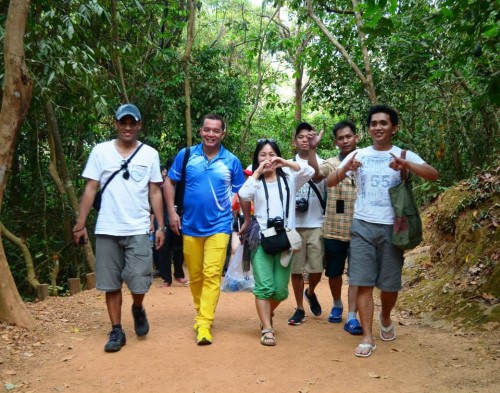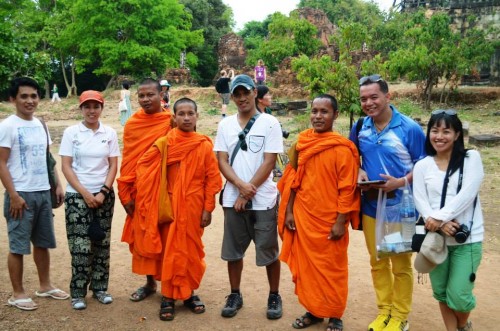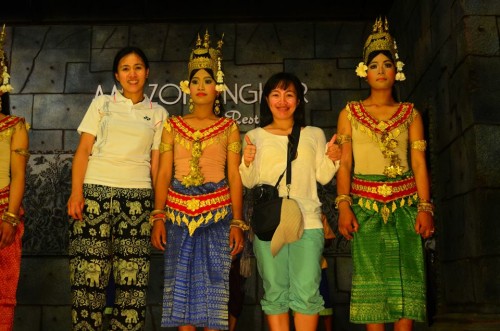As much as we want to catch each and every rising and setting of the sun, there are some sunsets that will prove elusive to us. And so we have to make do with what we get, and enjoy every moment of it.
On our first day in Siem Reap, we spent the morning at the Ton Le Sap, seeing how the “other half” of the province lives. After what was essentially an enlightening yet slightly-depressing morning, we had lunch, rested for a couple of hours, then went to the Angkor to purchase our passes.


We got the three-day pass, which is USD40.00.
Getting the pass during the afternoon will already allow us to check out the sunset at Phnom Bakheng. The days on our pass will start the next day, instead of that evening. So we went.
“Phnom”, in Khmer, means “hill”. So technically, we are at Bakheng Hill. Phnom Bakheng is considered to be the state temple of the first capital at Angkor.


There was a hike, then a long queue. There was already a crowd, which is a normal sight every afternoon in this place.


A few people more and we would have been allowed to go up the temple, but we weren’t able to make the 5pm cut-off. It was no great loss, since the overcast sky will not permit any glimpse of a decent sunset. Therefore, we just walked a bit around the temple to check it out.
Essentially, the highlight is the 13m-high pyramid, which is comprised of 5 terraces. At the summit is the temple itself, with the remains of the towers. Unfortunately, all that remains are shells and ruins. You can see restoration works ongoing, though.
Looking back, I’m kinda regretting not going back for a proper viewing of the temple on top and the sunset, at least before we left for home (the next day, it rained in the evening). They say you can get a fantastic view of Angkor Wat from the top, too. Oh well.





We also took photos with some monks. We called this the “monks and the Igorots” shot.

5:30 is closing time at Angkor – anywhere in the Angkor Archaeological Complex – so we proceeded to Amazon Angkor for a buffet dinner and a traditional Apsara show. It costs USD10.00 for the dinner AND the show.



The buffet dinner and Apsara Show at the Amazon Angkor was, for lack of a better word, overwhelming. All lengths and corners are set up with such a diverse selection of food that you won’t know where to start. If traditional Khmer dishes aren’t your thing, you can head over to the section with the grilled stuff, or the Chinese/Japanese food. There is something for everyone, even a sweets and desserts section.
And then, at exactly 7:30, the hour-long Apsara show started. From the start, I was amazed at the costumes. So rich and colorful!


Apsara, in Buddhist and Hindu mythology, is “a female spirit of the clouds and waters”. In this context, it is a Khmer classical dance, and also “the indigenous ballet-like performance art of Cambodia”. It’s serene, sublime, and the dancers are so graceful, from the movements of their hands, wrists and fingers, to the way their feet move. The gestures are supposed to narrate religious and mythical stories. One of these days, I might read more on this. I find it very interesting.
The first dance featured Apsaras, or the celestial nymphs. (I’m playing this by ear, since the acoustics for the speaker, as well as the accent, when she introduced each dance, was not so good as to be understood.)


This was followed by a Cambodian folk dance featuring coconut shells. Kinda like the Philippines’ maglalatik, but with some subtle differences.



It was then followed by another classical dance, this time featuring a princess/noblewoman and an ogre (asura).




Then another Cambodian folk dance. I heard the phrase “fishing dance”, and I recognized fishing instruments used. At the latter part of the dance, it became a courtship dance between a young man and a woman. Too bad, though, my camera battery is already failing me at this point.

The finale was, I think, another Apsara performance, a grander one, with more intricate costumes and gestures. I managed to get only one shot before my cam battery died on me. Bleh.

All in all, it was a very interesting watch. Those who are used to more spirited dances will most likely find it boring, since the music is also slow. I saw others nodding off, to be honest. At the end of the performance, the dancers stood onstage and the audience were allowed to have their photos taken alongside them.

Up close, they looked like dolls. Must be the makeup. Or maybe the serene/passive expressions on their faces? *shrugs*
Next post: Angkor Wat. ‘Nuff said. See ya then!
